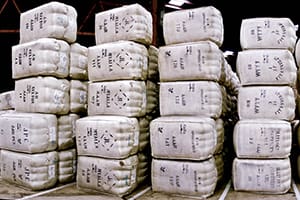 MERINO wool prices improved 10-40 cents a kilogram this week as buyers fought for market share, but crossbred values fell a further 20-30 cents.
MERINO wool prices improved 10-40 cents a kilogram this week as buyers fought for market share, but crossbred values fell a further 20-30 cents.
The AWEX Eastern Market Indicator closed 10c/kg clean higher on 1578c/kg, with brokers passing in 3.26 percent of the 43,473 bale offering.
AWEX said the value of wool sold on Australian auctions this year passed the one billion dollar mark this week, with sales of A$78.73 million in the 17th sale taking the value of year’s turnover to A$1.004 billion.
AWEX said it is the first time since 2002 that this milestone was achieved so early in the season.
“To put it into perspective, last season at the corresponding sale only 800 million dollars’ worth of wool had been sold, 26pc below the amount realised this year, even though total amount of bales sold was only 12pc lower.
“In the previous season, the billion-dollar amount was not achieved until week 21,” AWEX said.
AWEX said after the lacklustre performance of recent weeks, the market gained significant positive territory as strong buyer interest returned.
Although the focus continued to be on well measured wools, all types and descriptions in each micron range enjoyed similar gains as buyers fought for market share. Generally, prices rose by 10 to 40 cents across the entire Merino spectrum.
“Notably, the EMI lost 13 cents in US dollar terms (to $US1218c/kg) due to currency movement.”
AWEX said skirtings performed very well this week, with prices generally up by 20 to 50 cents. The low vegetable matter types (less than 2pc vm in particular) and wools less than 17.5 micron enjoyed the largest lift in price.
AWEX said as has been the case in recent sales, the crossbred market lacked buyer interest again this week. Generally, prices were reduced by 20 to 40 cents, any poorly prepared lines struggled to attract competition and experienced the largest reductions in price.
The oddment sector continued its upward trend this sale, AWEX said. Locks, stains and crutchings came under intense buyer pressure pushing prices up by 30 to 40 cents. A large offering of lambs was irregular, although, any wools 17.0 micron and finer were dearer, in some cases extreme regardless of length.
Currency movements were ‘advantageous’
Australian Wool Innovation said a large proportion of the gains this week can be put down to the advantageous currency movements against the Australian dollar. In its weekly market report, AWI said with all three of the major currencies used in wool trading depreciating by 1.8 to 2pc, an equalising factor was in play, as most Merino types appreciated in $A terms locally by similar amounts.
“The market adjustments on Merino wool wiped out the forex advantage, but shows the willingness of overseas manufacturers to keep supply up to their machines at the converted prices.
“It must be recognized though, that most of the manufacturing world considers Merino price levels to be “high”, particularly at the finest end of the clip,” AWI said.
AWI said only the carding wool sector prices outstripped any currency shift into the positive, but the carding market is largely the domain of the largest manufacturer and trader of these wools and it is assumed it would predominantly be using $As for purchases.
“The crossbred price worsens considerably as the double addition of local level loss and currency factors are combined.
“Global stocks mainly from outside of Australia remain the biggest inhibitor to any improving price scenario for crossbred wools,” AWI said.
“These wool types and descriptions are an important portion of the Australian wool clip and last season made up around 18pc of our clip, although this is down from the high of approximately 21pc of the clip six years ago in season 2011/12.”
AWI said this week’s auctions also featured some widely variable published results between centres.
“For super fine (less than 18.5 micron) Merino prices guides there are confusing disparities of between 50 to 100ac clean/kg between mainly the north and south levels.
“This area of the market is currently the most well sought after and it would seem strange if buyers of the same companies were using such differing prices between the centres.”
AWI said in general, the superfine Merino types registered gains of up to 50c/kg clean for the week, most of which came on the final day of selling.
“The 18.5 to 22 micron Merino wool descriptions sold 5 to 20c/kg clean dearer.
“Although competition was steady and enquiry consistent from overseas throughout, in US terms the prices actually fell, showing how some manufacturers are hitting perceived price resistance. Prompt and October shipment deadlines are fast approaching in the next few weeks, but the relatively larger volumes should see these outstanding orders easily catered for,” AWI said.
More than 47,000 bales are rostered to be sold in Australia next week.
“The trend is strong on Merino and weak on crossbred and nothing seems to be in play presently to change those expectations.”
Click here for the latest AWEX Micron Price Guides.
Sources: AWI, AWEX.

HAVE YOUR SAY